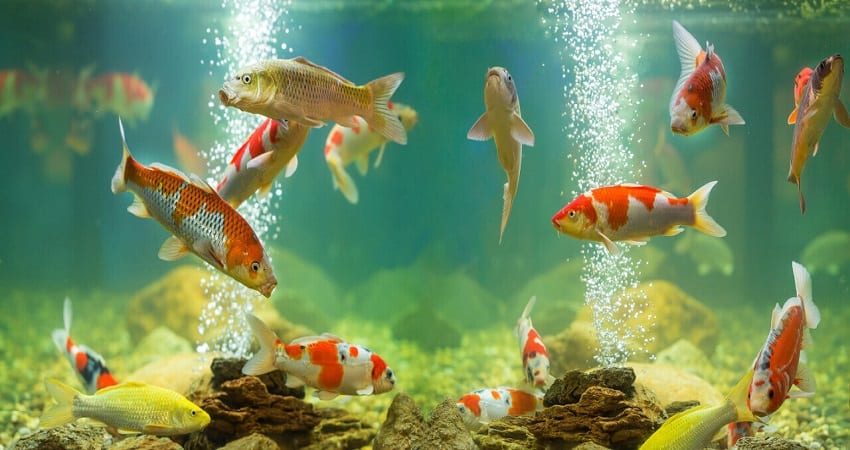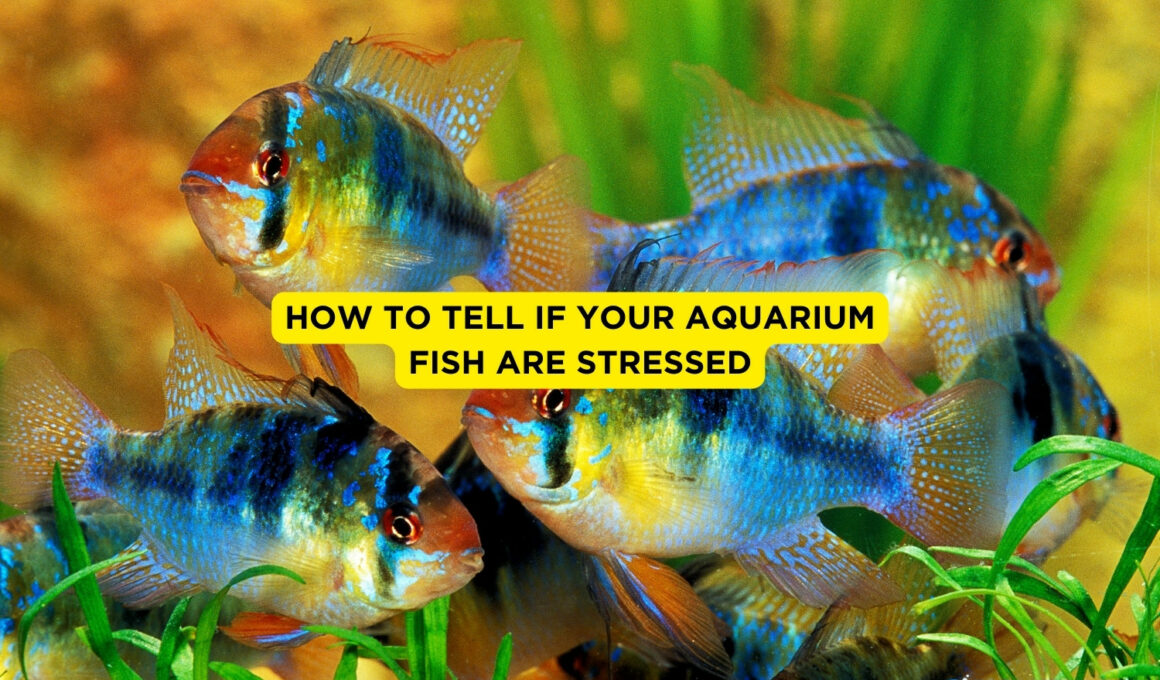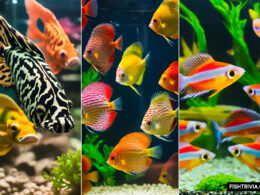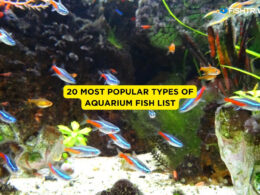In this article Show
Fish can experience stress in the same way that humans do. In reality, one of the most common causes of stress in fish is sudden environmental changes. This happens the majority of the time when we move them from one tank to another.
They become stressed when they are unable to find an environment which they have become accustomed to. Stress can cause serious health problems in fish, just as it can in humans.
Various factors can stress aquarium fish, and you should first learn to recognize the signs of stress, then take steps to identify the source of the stress and resolve it before it becomes a significant problem.
This article will discuss everything you may need to know about the sign of stress and how you can identify it.
Also worth reading;
- How Long Can Fish Go Without Food in an Aquarium?
- Freshwater Fish for 10-Gallon Tank: Which Are The Perfect?
- Aquarium Heater Size: What Size Heater Do You Need in a Fish Tank?
Symptoms That Will Help You Know That Your Fish Is Stressed
There are noticeable signs of stress in fish that serve as early indicators, and you should keep an eye on your fish for any of these signs.
1. Strange Swimming
When your fish is stressed, they will frequently swim in strange patterns. Your fish may be stressed if he is swimming frantically without going anywhere, rubbing himself against plants, rocks, and gravel, and crashing at the bottom of the tank.
2. Gasping At The Surface
If your fish continues to gasp at the surface of the water, it is a clear sign that they are under stress. This occurs due to a lack of oxygen in the aquarium water as well as poor water quality.
3. Avoiding Eating
Because they are unable to adapt to the water environment, stressed fish exhibit a lack of appetite. If your fish seems uninterested in food, he will often avoid eating.
4. Hiding
For most fish, hiding is a perfectly natural behavior, especially when they are first introduced to their new aquarium.
When there is much fish in an aquarium, they like to hide under rocks, plants, and wood inside the tank to relieve stress. But don’t be concerned about this sign. Simply ensure that your fish are comfortable and healthy.
5. Does Not Respond
Most people might think this is a symptom of being infected with the disease, but when we put new fish in an aquarium, they are not moving when other fish are attacking them because they are under stress.
But remember, it can be a symptom of the disease, and in the case of stress, it can happen when we put a new fish in a new aquarium.
What Causes Stress To Fish In An Aquarium
Anyone who owns a fish knows that they are complex creatures that various factors can cause.
It often takes a little detective work to figure out what is stressing your fish after seeing the symptoms and confirming that they are under stress. The following are some of the most common fish stressors.
1. Lack Of Water Changing
You need to keep up with water changes and tank cleanings. If you notice any water irregularities, you should be prepared to do a partial water change. pH, ammonia, and nitrogen content, such as nitrates and nitrites, must all be tested. Water can become toxic to your fish and stressful if you neglect these simple maintenance tasks.
2. Improper Temperature
Different fish species require different water temperatures throughout the day so sudden temperature changes can stress your fish.
When changing the water, make sure the new water would be at the temperature as the old water, and check the water temperature every day when you feed them.
3. Lack of Oxygen Level
Fish in aquariums are produced a lot of bio-waste, which causes a lot of toxicity in the water and is the leading cause of insufficient oxygen levels. Your fish will be stressed if the water has a low oxygen level.

4. Over-Crowded
Overcrowding is not only stressful for fish, but it is also stressful for all critters. They all need a certain amount of space to live and grow happily. Adding a large number of fish, on the other hand, produces a lot of waste, which increases waste output and causes water toxicity.
5. Sudden Addition To the Aquarium
Most people add their new fish suddenly in new water, and so fish feel so much stress. As they live in pet store aquarium water, when you put them in your new aquarium water, they can not cope with that water.
Beneficial bacteria can establish themselves, and nitrogen levels can be stabilized by cycling the tank.
6. Carnivorous Fish Mate
You must choose fish that are the same characteristic as a fish that is already in your aquarium. For example, if you choose goldfish as new mates in your aquarium and have already fish in your aquarium, which is carnivorous, you can take goldfish as food. It is full and can create an unstable condition. So choose those types of fish to add who have the same characteristic.
How To Reduce Stress From Aquarium
Providing a healthy environment for fish is the best way to prevent or reduce stress. But most people have a lack of knowledge about what is the perfect environment for their fish and how can they provide for them. But to make a beautiful environment, you need to pay attention to some before adding the process.
1. Wash Your Tank, Gravel, Rocks, And Other Ornaments
Before you put any fish in your tank, you’ll need to clean it and all of its contents, such as gravel, rocks, or ornaments. Do not wash with soap or detergent. Lukewarm water will suffice. This will help to remove dirt, bacteria, and toxins from these items.
2. Set The Air Pump For Sufficient Oxygen
You must ensure that the aquarium’s environment is sufficiently oxygenated. To hold the air tube, connect the airline tubing from the air pump to air outlets and a small valve located outside the tank. If the tank’s power is turned off, the valve also stops, preventing water from backing up in the tank.
3. Add Live Plant
Plants, both live and artificial, play an essential role in your aquarium. Live plants help circulate oxygen in the tank water, and it also gives your fish somewhere to hide.
4. Give Your Tank To Establish Themselves
Several types of bacteria aid in waste processing in an aquarium; they convert toxic ammonia from fish waste into nitrates that your plants can use as food.
However, this process takes time to complete, and getting the bacteria up and running in your tank takes time. As a result, we recommend that you give your tank to establish the nitrogen cycle process after planting a tree.
5. Add Fish Properly
Introduce new fish properly. Allow the unopened plastic bag containing the fish to float for 10-15 minutes on the aquarium’s surface to equalize the bag’s water temperature to the aquarium temperature.
Remember you need to fill 50% of the water and leave 50% of pet store water and do this process until the bag is full of your home water. Remember to release your new fish after 15-20 minutes by netting them in the bag and gently placing them into the aquarium’s water.
5. Check the Water Temperature Regularly
Different fish prefer different temperatures to stay healthy. Some wanted cold conditions in their water, and some wanted warm.
To avoid stressful fluctuations, try to maintain the temperature according to your chosen fish’s preferences. Check the water temperature for consistency regularly.
6. Remove Aggressive Fish To a Separate Tank
Since aggressive fish can not make a friendship with your cute, polite, sweet little fish. So the good idea is to separate them in another tank.
7. Change Water Frequently
To keep nitrate and ammonia levels low, change the water frequently. When you keep the same water in your aquarium for several days, toxicity levels such as nitrate and ammonia can be high, resulting in many bacteria and fish waste.
Frequently Asked Questions
What are the symptoms of ammonia poisoning fish?
At first glance, the fish might appear to be gasping for air. Their gills will turn a reddish-purple color, making them appear to be bleeding. As their bodily functions crumble, your fish will lose their appetite and become increasingly sedentary.
How can I get more oxygen in my aquarium?
In an emergency, you can quickly increase your aquarium’s oxygen level by pouring aquarium water down from a height using a jar. To increase oxygen in the fish tank, you can do a significant water change of up to 50% of the water.
How can I get more oxygen in my aquarium?
In an emergency, you can quickly increase your aquarium’s oxygen level by pouring aquarium water down from a height using a jar. To increase oxygen in the fish tank, you can do a significant water change of up to 50% of the water.
Is too much aeration good for fish?
Too much oxygen in the water can cause the potentially fatal gas bubble disease, in which gas bubbles form in the fish’s skin and around its eyes as a result of gas coming out of the solution inside the fish.
Does filtering well to provide oxygen?
Yes, filters help increase oxygen in the water by causing water movement at the surface, where oxygen exchange occurs.
How many times should I need to change my aquarium water in a week?
Every two to four weeks you should change 25% of the water. During the water change, there is no need to remove the fish. Please remove the gravel or use a gravel cleaner during the change of water.
Final Words
You might think that aquarium fish are such sensitive creatures after reading this. Still, many species can tolerate minor changes in aquarium conditions, but excessive stress is difficult for them to tolerate.
Stress is entirely dependent on the environment in which you place them. Because different species used to live in different environments must determine the ideal environment for your fish before implementing the idea.










